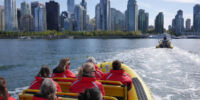
Five Traits of a Meaningfully Accessible Building
Author: Brad McCannell (September 2018) repurposed with permission from the Rick Hansen Foundation.
One of the most common misconceptions I encounter when discussing accessibility is ‘I’m already accessible, because my building meets code’. However, building code does not regulate emergency evacuation plans for people with disabilities, and it generally only accounts for wheelchair users. It does not account for disabilities in the areas of agility, hearing, vision and cognition, and people who use wheelchairs have dominated the conversation. Meeting code does not equal meaningful access for all users.
Meaningful access recognizes that the whole is greater than the sum of its parts. Building code might indicate that there should be a ramp next to the stairs. However, the ramp could have a 1/8th slope, which some people could roll up, but I can’t. Meaningful access considers all the users, and their entire experience. From the moment they arrive, it’s the path to the door, it’s the door itself, it’s going through it, it’s everything the user does inside the building and how they leave.
A building with meaningful access has a few distinctive traits. These traits are not the nuts and bolts of how steep your ramp should be. Instead, they are the outcome, they are what you achieve when all of your accessible features come together. The whole is greater than the sum of its parts.
What are the Five Traits of a Meaningfully Accessible Building?
1. A Warm and Welcoming Environment
A warm and welcoming environment is more than just a feeling. It is something that can be built, in both the exterior and interior of the building. Is it obvious where the front door is? And when you get there, is there a power door opener? Is there shelter? A warm and welcoming environment is one where the built environment makes all users feel like they belong.
Examples of Accessible Features:
- A reception desk which is 36 inches high instead of the more common height of 42 inches. This allows the receptionist to make eye contact with someone using a wheeled mobility device. With the lower desk, I don’t feel like I am putting anyone out, by making the receptionist get up and walk around the desk to talk to me.
- An induction loop, also known as hearing loop or an FM loop, is a mini radio station that broadcasts to a small area. Anyone with a hearing aid can pick up the frequency. For example, airports install them because all their ambient noise can make announcements overwhelming for people who use hearing aids. At Roger’s Arena in Vancouver, the whole building has an induction loop, allowing visitors to tap into the PA system from the stands. It’s a huge benefit to the community, and it’s invisible. Additionally, it costs very little. Having one in a meeting room or a classroom would change how people participate and how much they comprehend.
2. An Emergency Evacuation Plan which Considers All Users
Building code works hard at getting me in a building but is not concerned with getting me out. One of the biggest problems we have as a community is that according to code, egress does not have to be accessible. Elevators have plaques which say, in case of fire, use the stairs. Where’s the plaque that says what people with physical disabilities are supposed to do in case of fire?
Examples of Accessible Features:
- An area of refuge on each floor, where people who cannot use the stairs can gather and wait for firefighters. It needs a two-hour fire separation and a separate air supply.
- An emergency power supply on all the power operated doors. If the power goes out, those doors are heavy. I would be effectively trapped.
- A visual fire alarm. If you don’t have one, the expectation is someone will tell someone who is deaf or hard-of-hearing if there is a fire. However, that means these people can never stay late or work alone. That’s not practical and is also a barrier to employment. As a barrier to employment, a lack of visual fire alarms is both a HR issue and a human rights issue.
3. Inclusive and Comprehensive Wayfinding
Consistent and intuitive sensory clues direct the user throughout the building. If you have intuitive wayfinding it touches so many different disability groups including the mental health community. It removes stress and anxiety about moving through public spaces. Signage is a huge part of it, but there’s so much more than that. It’s in the materials of the floor, the colours on the walls, and the placement of artwork. On BC Ferries, people kept getting lost trying to find their cars at the end of the trip. They now have giant images of starfish and other sea creatures on each of the parking levels, one for each floor. That’s wayfinding.
Examples of Accessible Features:
- Blade signage instead of flat signage for washrooms and other important locations allow people to locate their destination from the end of the hall. As a person with a physical disability, going the wrong way is very frustrating!
- The use of textures or colour schemes to indicate where you are in the space. At YVR airport, if you are standing on top of tile you are connected to an exit. If you are on carpet, you are connected to a gate. If you are on anything else, you are in retail. If you don’t need it, you would never notice it.
4. No Barriers to Employment
People who have physical disabilities should have access to a space as a consumer, visitor, and importantly, as an employee. Inclusive hiring opens up one of the largest untapped labour markets in Canada. According to the Conference Board of Canada, 57 percent of people with disabilities who are ready, willing and able to work can’t because of physically inaccessible workplaces. All employers have to do is let us in the door, literally. We are an incredible pool of talented people.
Examples of Accessible Features:
- Accessible washrooms for both staff and customers throughout the building.
- An inclusive hiring policy and disability awareness training in place for staff.
5. Circulation is Barrier-Free and Safe
The methods by which people move through the space, like stairs, corridors, elevators and doors, are built to accommodate all users, and take user safety into account.
Examples of Accessible Features:
- A mirror on the back of an elevator is a game changer from a safety perspective in certain elevators. Before I get into the elevator, I can make the decision to either get in to the elevator or not because I can see all the occupants and asses how safe I feel. The Disabled Women’s Network says that 73% of women with disabilities are sexually assaulted, which is a terrifying statistic. Additionally, if the elevator is crowded and you can’t turn your chair, it allows you to look in the mirror to see the exit and simply back up to get out.
- High contrast paint and glow-in-the-dark nosing on the stairs, as well as handrails on both sides of the stairs. During 9/11, hundreds of lives were saved due to glow-in-the-dark nosing on the stairs. After the power went out, people in the stairwells were still able to navigate the stairs safely.
Creating Inclusive Communities
Excellent meaningful access is invisible. Vancouver International Airport is one of the most accessible airports in the world. When I get asked for pictures of the accessible features, I have to say no. It is too comprehensive to capture in an image, and it is invisible if you do it right. We do exit surveys, and we ask people with disabilities how they found their experience using the airport. They say ‘it was great!’, but when we ask why, they don’t know. If they knew, it would be because they were taken down a different ramp or served at a different counter. Universal design creates environments which are usable by all people, to the greatest extent possible, without the need for adaptation. It creates inclusivity. Inclusion is not a single thing, it is an outcome. You take a barrier and solve it. You make it accessible. And if you do that enough times, the building itself becomes accessible, and accessibility brings inclusion.
Inclusion is what happens when my 89-year–old mother comes to the game to watch her grandson without even thinking about it. But when she hesitates and stays home, because the stairs are too steep or because the sidewalk is not connected to the door, the fabric of the community starts to tear. When intergenerational living starts to improve, there’s less distance between grandmother and grandson, and between people and their community.
Creating meaningful access builds an inclusive community.





